Statistical Modeling on the Severity of Unhealthy Air Pollution Events in Malaysia
Abstract
:1. Introduction
- To analyze the behaviors of an air pollution event based on the measure of severity size;
- To determine a suitable statistical model for describing the probabilistic behaviors of air pollution severity size;
- To evaluate the expected risk of air pollution severity size based on the concept of return period.
2. Study Area and Data
3. Statistical Methodologies
3.1. Air Pollution Severity Size
3.2. Maximum-Values Based on Monsoon Seasons
3.3. Extreme-Value Modeling
3.4. Methods of Parameter Estimation
3.4.1. L-Moment Estimation
3.4.2. Maximum Likelihood Estimation (MLE)
3.4.3. Generalized Maximum Likelihood Estimation (GMLE)
4. Results and Discussion
5. Conclusions
Author Contributions
Funding
Institutional Review Board Statement
Informed Consent Statement
Data Availability Statement
Acknowledgments
Conflicts of Interest
References
- Thunis, P. On the validity of the incremental approach to estimate the impact of cities on air quality. Atmos. Environ. 2018, 173, 210–222. [Google Scholar]
- Yang, J.; Shi, B.; Shi, Y.; Marvin, S.; Zheng, Y.; Xia, G. Air pollution dispersal in high density urban areas: Research on the triadic relation of wind, air pollution, and urban form. Sustain. Cities Soc. 2020, 54, 101941. [Google Scholar]
- An, Z.; Jin, Y.; Li, J.; Li, W.; Wu, W. Impact of particulate air pollution on cardiovascular health. Curr. Allergy Asthma Rep. 2018, 18, 15. [Google Scholar]
- Sah, D.; Verma, P.K.; Kandikonda, M.K.; Lakhani, A. Pollution characteristics, human health risk through multiple exposure pathways, and source apportionment of heavy metals in PM10 at Indo-Gangetic site. Urban Clim. 2019, 27, 149–162. [Google Scholar]
- Whyand, T.; Hurst, J.R.; Beckles, M.; Caplin, M.E. Pollution and respiratory disease: Can diet or supplements help? A review. Respir. Res. 2018, 19, 79. [Google Scholar] [PubMed] [Green Version]
- Saud, B.; Paudel, G. The threat of ambient air pollution in Kathmandu, Nepal. J. Environ. Public Health 2018, 2018, 1504591. [Google Scholar]
- Mannucci, P.M.; Franchini, M. Health effects of ambient air pollution in developing countries. Int. J. Environ. Res. Public Health 2017, 14, 1048. [Google Scholar]
- Al-Kindi, S.G.; Brook, R.D.; Biswal, S.; Rajagopalan, S. Environmental determinants of cardiovascular disease: Lessons learned from air pollution. Nat. Rev. Cardiol. 2020, 17, 656–672. [Google Scholar]
- Elleuch, B.; Bouhamed, F.; Elloussaief, M.; Jaghbir, M. Environmental sustainability and pollution prevention. Environ. Sci. Pollut. Res. 2018, 25, 18223–18225. [Google Scholar]
- Ionescu, L. Leveraging green finance for low-carbon energy, sustainable economic development, and climate change mitigation during the COVID-19 pandemic. Rev. Contemp. Philos. 2021, 20, 175–186. [Google Scholar]
- Ionescu, L. Transitioning to a low-carbon economy: Green financial behavior, climate change mitigation, and environmental energy sustainability. Geopolit. Hist. Int. Relat. 2021, 13, 86–96. [Google Scholar]
- Hamanaka, R.B.; Mutlu, G.M. Particulate matter air pollution: Effects on the cardiovascular system. Front. Endocrinol. 2018, 9, 680. [Google Scholar] [CrossRef] [PubMed] [Green Version]
- Sanyal, S.; Rochereau, T.; Maesano, C.N.; Com-Ruelle, L.; Annesi-Maesano, I. Long-term effect of outdoor air pollution on mortality and morbidity: A 12-year follow-up study for Metropolitan France. Int. J. Environ. Res. Public Health 2018, 15, 2487. [Google Scholar] [CrossRef] [PubMed] [Green Version]
- Davidson, N.; Mariev, O.; Turkanova, S. Does income inequality matter for CO2 emissions in Russian regions? Equilibrium. Q. J. Econ. Econ. Policy 2021, 16, 533–551. [Google Scholar]
- Ionescu, L. Corporate environmental performance, climate change mitigation, and green innovation behavior in sustainable finance. Econ. Manag. Financ. Mark. 2021, 16, 94–106. [Google Scholar]
- Lu, J.G. Air pollution: A systematic review of its psychological, economic, and social effects. Curr. Opin. Psychol. 2020, 32, 52–65. [Google Scholar] [CrossRef]
- Lü, J.; Liang, L.; Feng, Y.; Li, R.; Liu, Y. Air pollution exposure and physical activity in China: Current knowledge, public health implications, and future research needs. Int. J. Environ. Res. Public Health 2015, 12, 14887–14897. [Google Scholar] [CrossRef] [PubMed]
- Vert, C.; Sánchez-Benavides, G.; Martínez, D.; Gotsens, X.; Gramunt, N.; Cirach, M.; Molinuevo, J.L.; Sunye, J.; Nieuwenhuijsen, M.J.; Crous-Bou, M.; et al. Effect of long-term exposure to air pollution on anxiety and depression in adults: A cross-sectional study. Int. J. Hyg. Environ. Health 2017, 220, 1074–1080. [Google Scholar] [CrossRef]
- Zhang, H.; Chen, J.; Wang, Z. Spatial heterogeneity in spillover effect of air pollution on housing prices: Evidence from China. Cities 2021, 113, 103145. [Google Scholar] [CrossRef]
- Cabaneros, S.M.; Calautit, J.K.; Hughes, B.R. A review of artificial neural network models for ambient air pollution prediction. Environ. Model. Softw. 2019, 119, 285–304. [Google Scholar] [CrossRef]
- Liu, D.-R.; Hsu, Y.-K.; Chen, H.-Y.; Jau, H.-J. Air pollution prediction based on factory-aware attentional LSTM neural network. Computing 2021, 103, 75–98. [Google Scholar]
- Mao, W.; Wang, W.; Jiao, L.; Zhao, S.; Liu, A. Modeling air quality prediction using a deep learning approach: Method optimization and evaluation. Sustain. Cities Soc. 2021, 65, 102567. [Google Scholar]
- Fan, H.; Zhao, C.; Yang, Y. A comprehensive analysis of the spatio-temporal variation of urban air pollution in China during 2014–2018. Atmos. Environ. 2020, 220, 117066. [Google Scholar]
- Liu, X.; Hadiatullah, H.; Tai, P.; Xu, Y.; Zhang, X.; Schnelle-Kreis, J.; Schloter-Hai, B.; Zimmermann, R. Air pollution in Germany: Spatio-temporal variations and their driving factors based on continuous data from 2008 to 2018. Environ. Pollut. 2021, 276, 116732. [Google Scholar] [PubMed]
- Kamińska, J.A. The use of random forests in modelling short-term air pollution effects based on traffic and meteorological conditions: A case study in Wrocław. J. Environ. Manag. 2018, 217, 164–174. [Google Scholar]
- Yu, M.; Cai, X.; Xu, C.; Song, Y. A climatological study of air pollution potential in China. Theor. Appl. Climatol. 2019, 136, 627–638. [Google Scholar]
- Hodgson, E.C.; Phillips, I.D. Seasonal variations in the synoptic climatology of air pollution in Birmingham, UK. Theor. Appl. Climatol. 2021, 146, 1421–1439. [Google Scholar]
- Bose, M.; Larson, T.; Szpiro, A.A. Adaptive predictive principal components for modeling multivariate air pollution. Environmetrics 2018, 29, e2525. [Google Scholar]
- Hajmohammadi, H.; Heydecker, B. Multivariate time series modelling for urban air quality. Urban Clim. 2021, 37, 100834. [Google Scholar]
- Masseran, N.; Hussain, S.I. Copula modelling on the dynamic dependence structure of multiple air pollutant variables. Mathematics 2020, 8, 1910. [Google Scholar]
- Todorov, V.; Dimov, I. Innovative digital stochastic methods for multidimensional sensitivity analysis in air pollution modelling. Mathematics 2022, 10, 2146. [Google Scholar]
- Masseran, N. Modeling the characteristics of unhealthy air pollution events: A copula approach. Int. J. Environ. Res. Public Health 2021, 18, 8751. [Google Scholar] [PubMed]
- Vivanco-Hidalgo, R.M.; Avellaneda-Gómez, C.; Dadvand, P.; Cirach, M.; Ois, Á.; González, A.G.; Rodriguez-Campello, A.; de Ceballos, P.; Basagaña, X.; Zabalza, A.; et al. Association of residential air pollution, noise, and greenspace with initial ischemic stroke severity. Environ. Res. 2019, 179, 108725. [Google Scholar]
- Domingo, J.L.; Rovira, J. Effects of air pollutants on the transmission and severity of respiratory viral infections. Environ. Res. 2020, 187, 109650. [Google Scholar] [PubMed]
- Marquès, M.; Domingo, J.L. Positive association between outdoor air pollution and the incidence and severity of COVID-19. A review of the recent scientific evidences. Environ. Res. 2022, 203, 111930. [Google Scholar]
- Google Maps. 2019. Available online: https://www.google.com/maps/place/Klang,+Selangor/@3.2467558,101.2650693,9.1z/data=!4m5!3m4!1s0x31cc534c4ffe81cf:0xeb61f5772fd54514!8m2!3d3.044917!4d101.4455621 (accessed on 23 March 2019).
- Dominick, D.; Juahir, H.; Latif, M.T.; Zain, S.M.; Aris, A.Z. Spatial assessment of air quality patterns in Malaysia using multivariate analysis. Atmos. Environ. 2012, 60, 172–181. [Google Scholar]
- Department of Environment. A Guide to Air Pollutant Index in Malaysia (API); Ministry of Science, Technology and the Environment: Kuala Lumpur, Malaysia, 1997; Available online: https://aqicn.org/images/aqi-scales/malaysia-api-guide.pdf (accessed on 5 June 2018).
- Al-Dhurafi, N.A.; Masseran, N.; Zamzuri, Z.H.; Razali, A.M. Modeling unhealthy air pollution index using a peaks-over-threshold method. Environ. Eng. Sci. 2018, 35, 101–110. [Google Scholar]
- Masseran, N.; Razali, A.M.; Ibrahim, K.; Latif, M.T. Modeling air quality in main cities of Peninsular Malaysia by using a generalized Pareto model. Environ. Monit. Assess. 2016, 188, 65. [Google Scholar]
- Masseran, N. Power-law behaviors of the severity levels of unhealthy air pollution events. Nat. Hazards 2022, 112, 1749–1766. [Google Scholar]
- Masseran, N. Power-law behaviors of the duration size of unhealthy air pollution events. Stoch. Environ. Res. Risk Assess. 2021, 35, 1499–1508. [Google Scholar]
- Azmi, S.Z.; Latif, M.T.; Ismail, A.S.; Juneng, L.; Jemain, A.A. Trend and status of air quality at three different monitoring stations in the Klang Valley, Malaysia. Air Qual. Atmos. Health 2010, 3, 53–64. [Google Scholar] [PubMed] [Green Version]
- Ku Yaacob, K.K.; Ali, A.; Mohd Isa, M. Keadaan Laut Perairan Semenanjung Malaysia Untuk Panduan Nelayan. Jabatan Perikanan Malaysia. 2007. Available online: https://repository.seafdec.org.my/bitstream/handle/20.500.12561/313/Keadaan%20Laut%20Perairan%20Semenanjung%20Malaysia%20Untuk%20Panduan%20Nelayan_DPPSPM%20DOF.pdf?sequence=1&isAllowed=y (accessed on 25 February 2019).
- Kütchenhoff, H.; Thamerus, M. Extreme value analysis of Munich air pollution data. Environ. Ecol. Stat. 1996, 3, 127–141. [Google Scholar]
- Reyes, H.J.; Vaquera, H.; Villaseñor, J.A. Estimation of trends in high urban ozone levels using the quantiles of (GEV). Environmetrics 2010, 21, 127–141. [Google Scholar]
- Reiss, R.-D.; Thomas, M. Statistical Analysis of Extreme Values: With Application to Insurance, Finance, Hydrology and Other Fields; Die Deutsche Bibliothek: Berlin, Germany, 2007. [Google Scholar]
- French, J.; Kokoszka, P.; Stoev, S.; Hall, L. Quantifying the risk of heat waves using extreme value theory and spatio-temporal functional data. Comput. Stat. Data Anal. 2019, 131, 176–193. [Google Scholar]
- Panagoulia, D.; Economou, P.; Caroni, C. Stationary and nonstationary generalized extreme value modelling of extreme precipitation over a mountainous area under climate change. Environmetrics 2014, 25, 29–43. [Google Scholar]
- Yoon, S.; Kumphon, B.; Park, J.-S. Spatial modeling of extreme rainfall in northeast Thailand. J. Appl. Stat. 2015, 42, 1813–1828. [Google Scholar]
- Cocchi, D.; Scagliarini, M. Modelling extreme rainfall data within a catchment region. Environmetrics 2003, 14, 11–26. [Google Scholar]
- Coles, S. An Introduction to Statistical Modeling of Extreme Values; Springer: London, UK, 2001. [Google Scholar]
- Scotto, M.G.; Barbosa, S.M.; Alonso, A.M. Extreme value and cluster analysis of European daily temperature series. J. Appl. Stat. 2011, 38, 2793–2804. [Google Scholar]
- Katz, R.W.; Parlange, M.B.; Naveau, P. Statistics of extremes in hydrology. Adv. Water Resour. 2002, 25, 1287–1304. [Google Scholar]
- Sadegh, M.; Moftakhari, H.; Gupta, H.V.; Ragno, E.; Mazdiyasni, O.; Sanders, B.; Matthew, R.; AghaKouchak, A. Multihazard scenarios for analysis of compound extreme events. Geophys. Res. Lett. 2018, 45, 5470–5480. [Google Scholar]
- Hosking, J.R.M. L-Moments: Analysis and estimation of distributions using linear combinations of order statistics. J. R. Stat. Soc. Ser. B Stat. Methodol. 1990, 52, 105–124. [Google Scholar] [CrossRef]
- Lee, S.H.; Maeng, S.J. Frequency analysis of extreme rainfall using L-moment. Irrig. Drain. 2003, 52, 219–230. [Google Scholar] [CrossRef]
- Noto, L.V.; La Loggia, G. Use of L-moments approach for regional flood frequency analysis in Sicily, Italy. Water Resour. Manag. 2009, 23, 2207–2229. [Google Scholar] [CrossRef]
- Hosking, J.R.M. Algorithm as 215: Maximum-likelihood estimation of the parameters of the generalized extreme-value distribution. J. R. Stat. Soc. Ser. C Appl. Stat. 1985, 34, 301–310. [Google Scholar] [CrossRef]
- Martins, E.S.; Stedinger, J.R. Generalized maximum-likelihood generalized extreme-value quantile estimators for hydrologic data. Water Resour. Res. 2000, 36, 737–744. [Google Scholar] [CrossRef]
- Gilleland, E.; Katz, R.W. extRemes 2.0: An extreme value analysis package in R. J. Stat. Softw. 2016, 72, 1–39. [Google Scholar] [CrossRef] [Green Version]
- Gilleland, E. extRemes: Extreme Value Analysis. R Package Version 2.1-2. Available online: https://cran.r-project.org/web/packages/extRemes/extRemes.pdf (accessed on 4 June 2021).
- Cooley, D. Return periods and return levels under climate change. In Extremes in a Changing Climate. Water Science and Technology Library; AghaKouchak, A., Easterling, D., Hsu, K., Schubert, S., Sorooshian, S., Eds.; Springer: Dordrecht, The Netherlands, 2013; Volume 65, pp. 97–114. [Google Scholar]
- McPhillips, L.E.; Chang, H.; Chester, M.V.; Depietri, Y.; Friedman, E.; Grimm, N.B.; Kominoski, J.S.; McPhearson, T.; Méndez-Lázaro, P.; Rosi, E.J.; et al. Defining extreme events: A cross-disciplinary review. Earth’s Future 2018, 6, 441–455. [Google Scholar] [CrossRef]
- Usmani, R.S.A.; Saeed, A.; Abdullahi, A.M.; Pillai, T.R.; Jhanjhi, N.Z.; Hashem, I.A.T. Air pollution and its health impacts in Malaysia: A review. Air Qual. Atmos. Health 2020, 13, 1093–1118. [Google Scholar] [CrossRef]
- Chin, Y.S.J.; De Pretto, L.; Thuppil, V.; Ashfold, M.J. Public awareness and support for environmental protection–A focus on air pollution in peninsular Malaysia. PLoS ONE 2019, 14, e0212206. [Google Scholar]

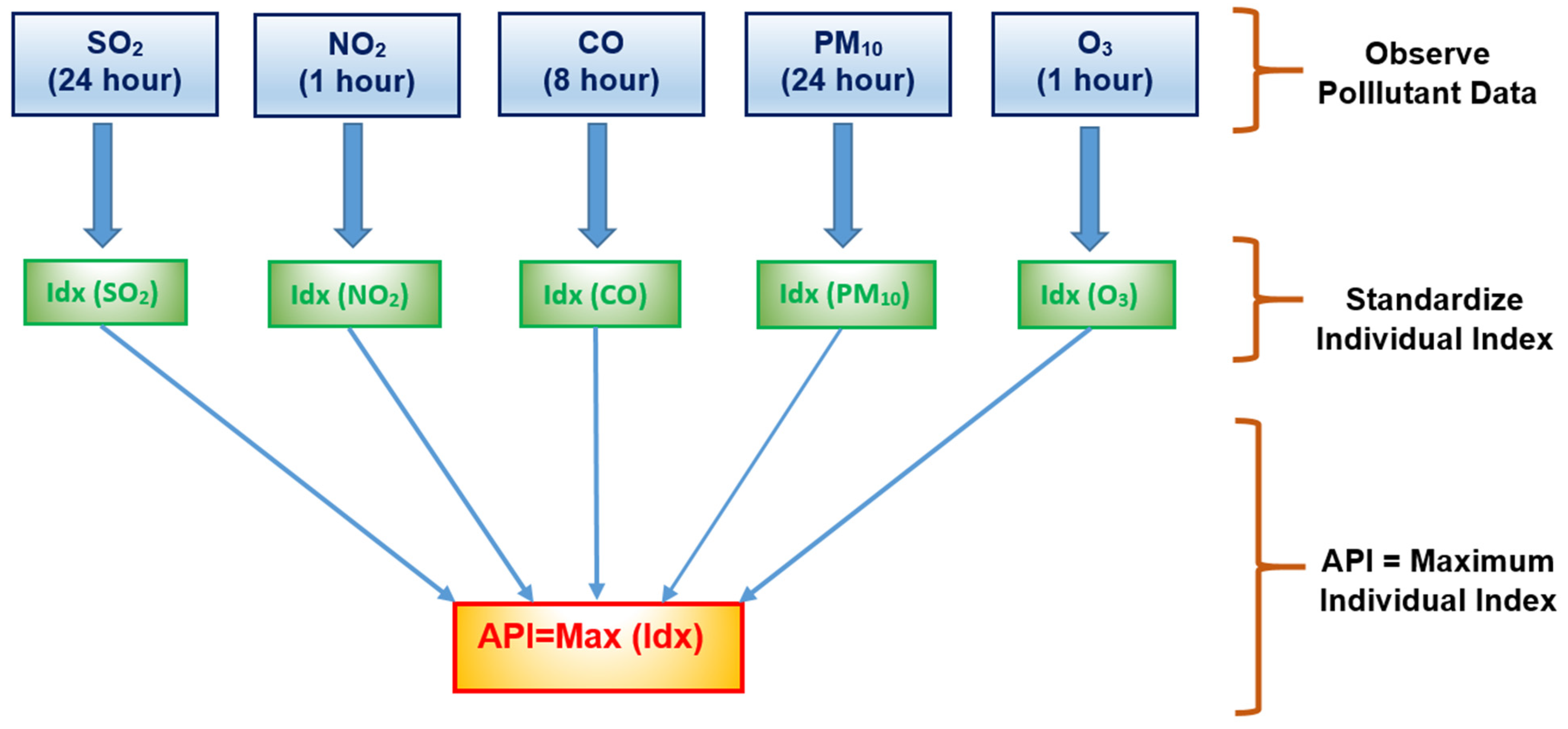
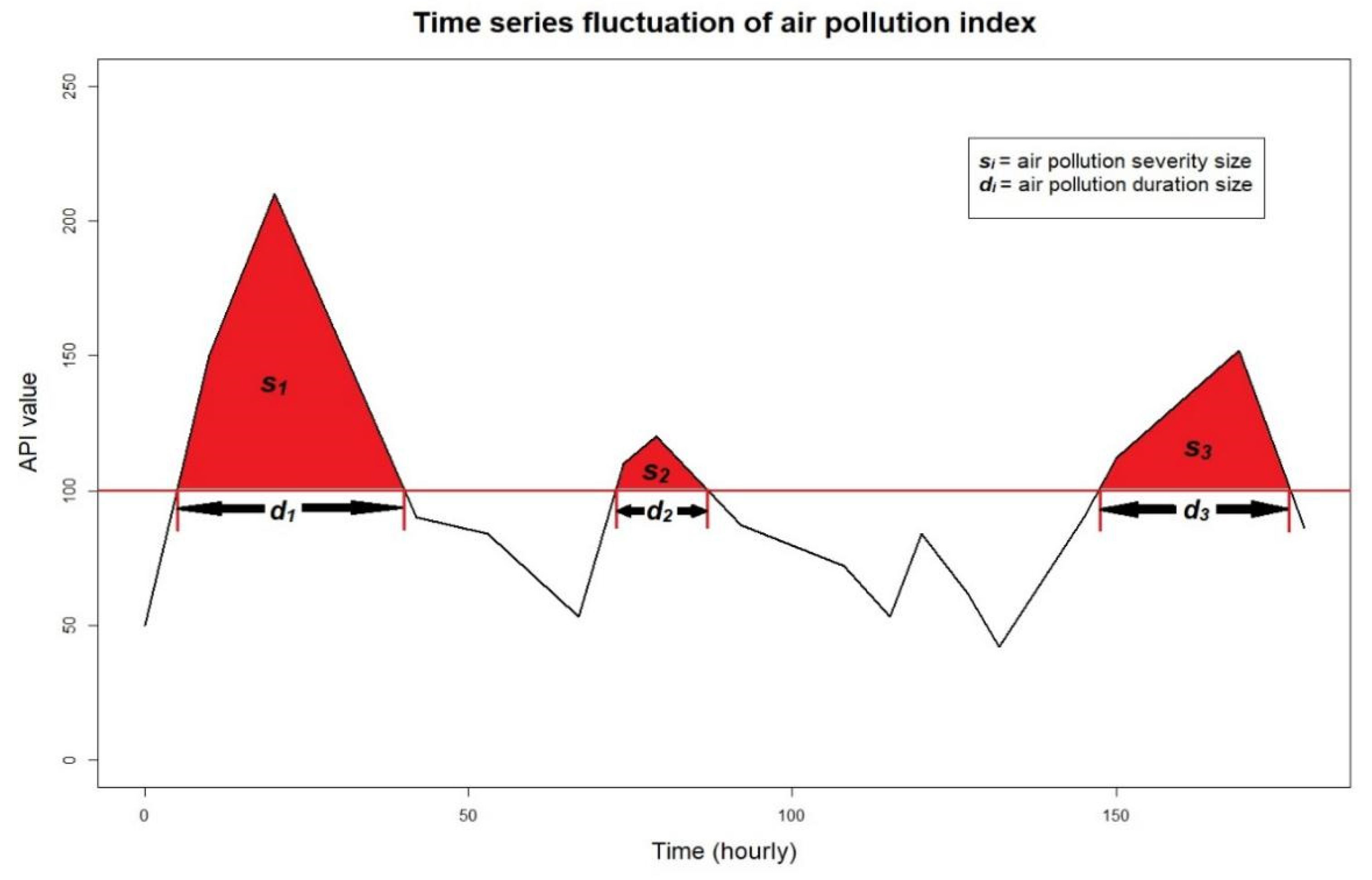
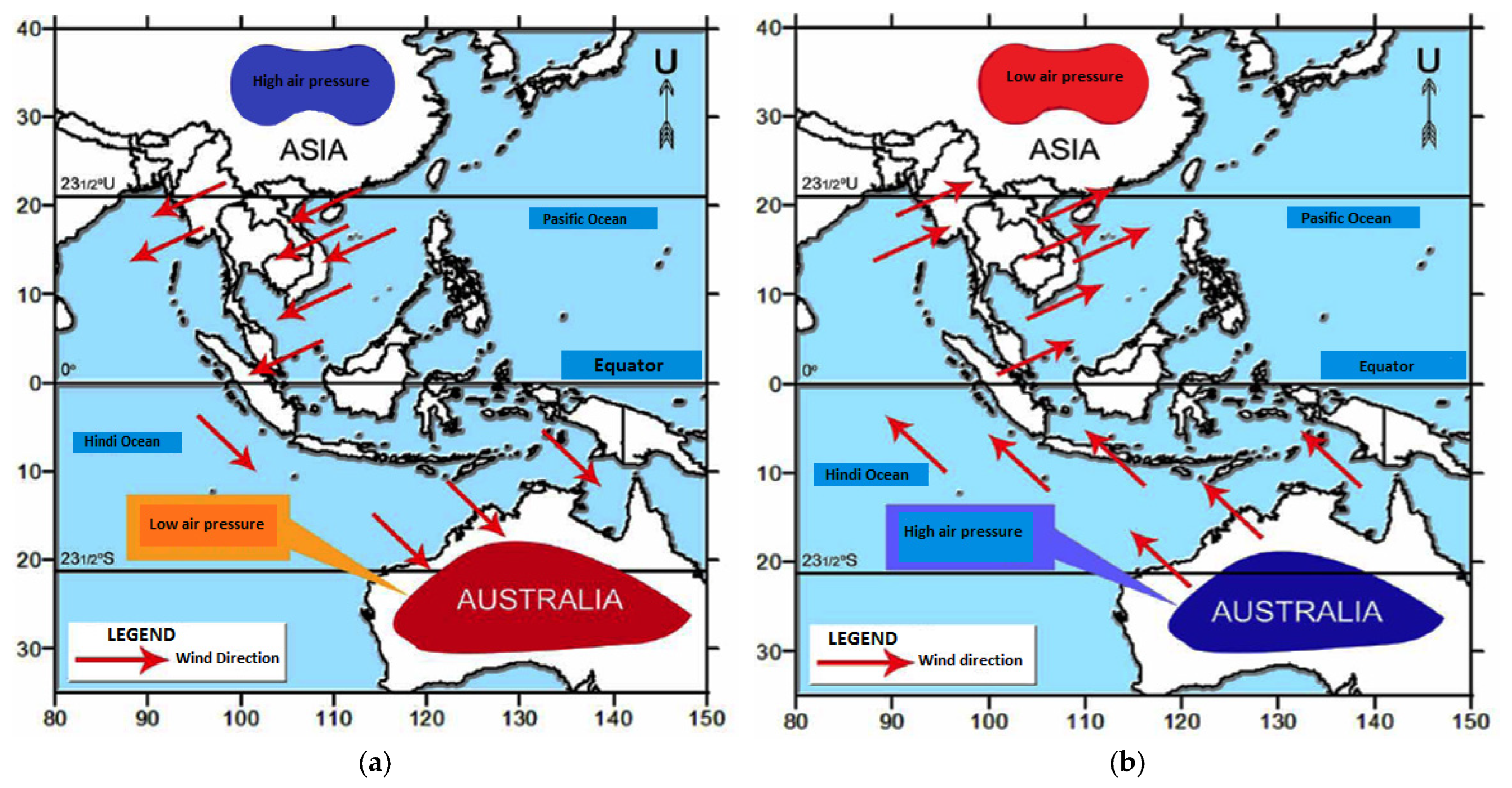
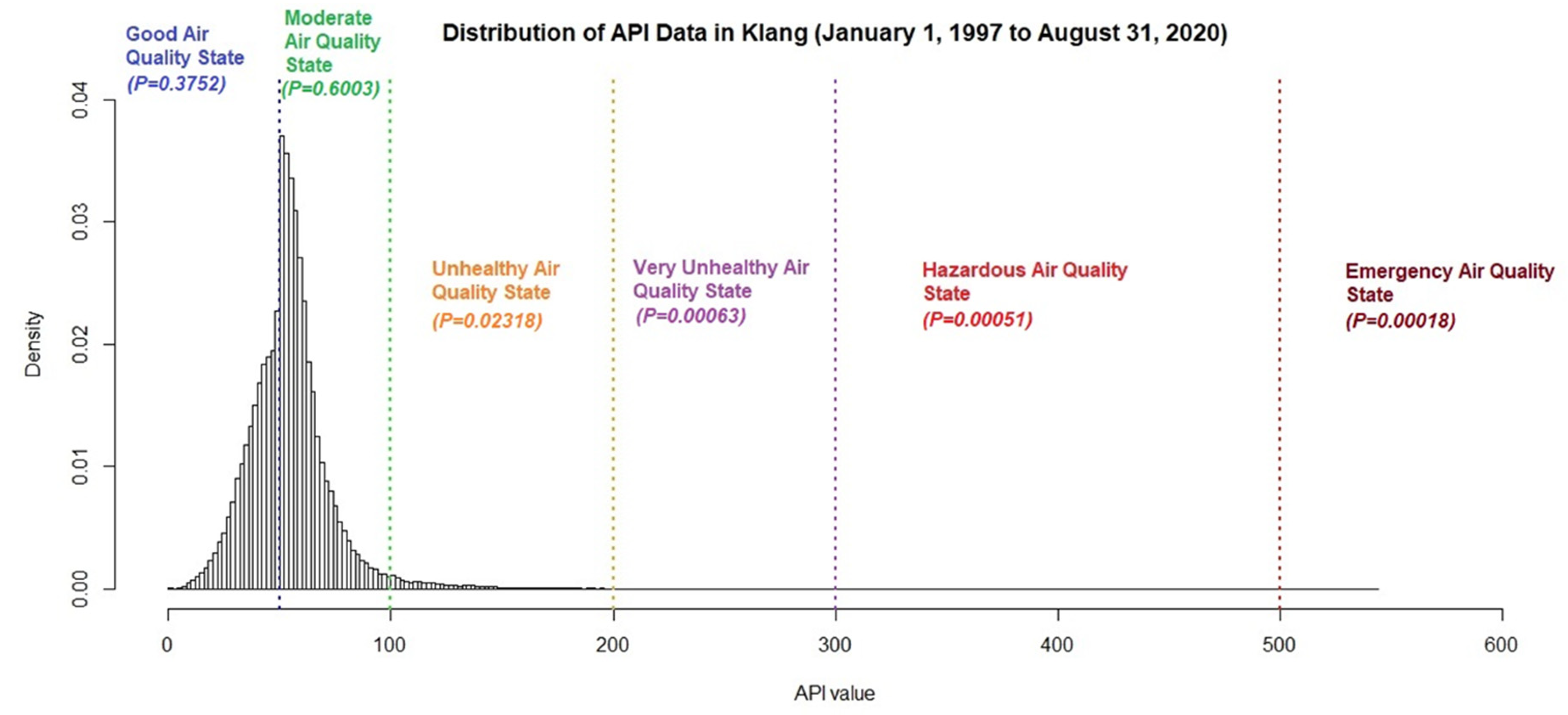
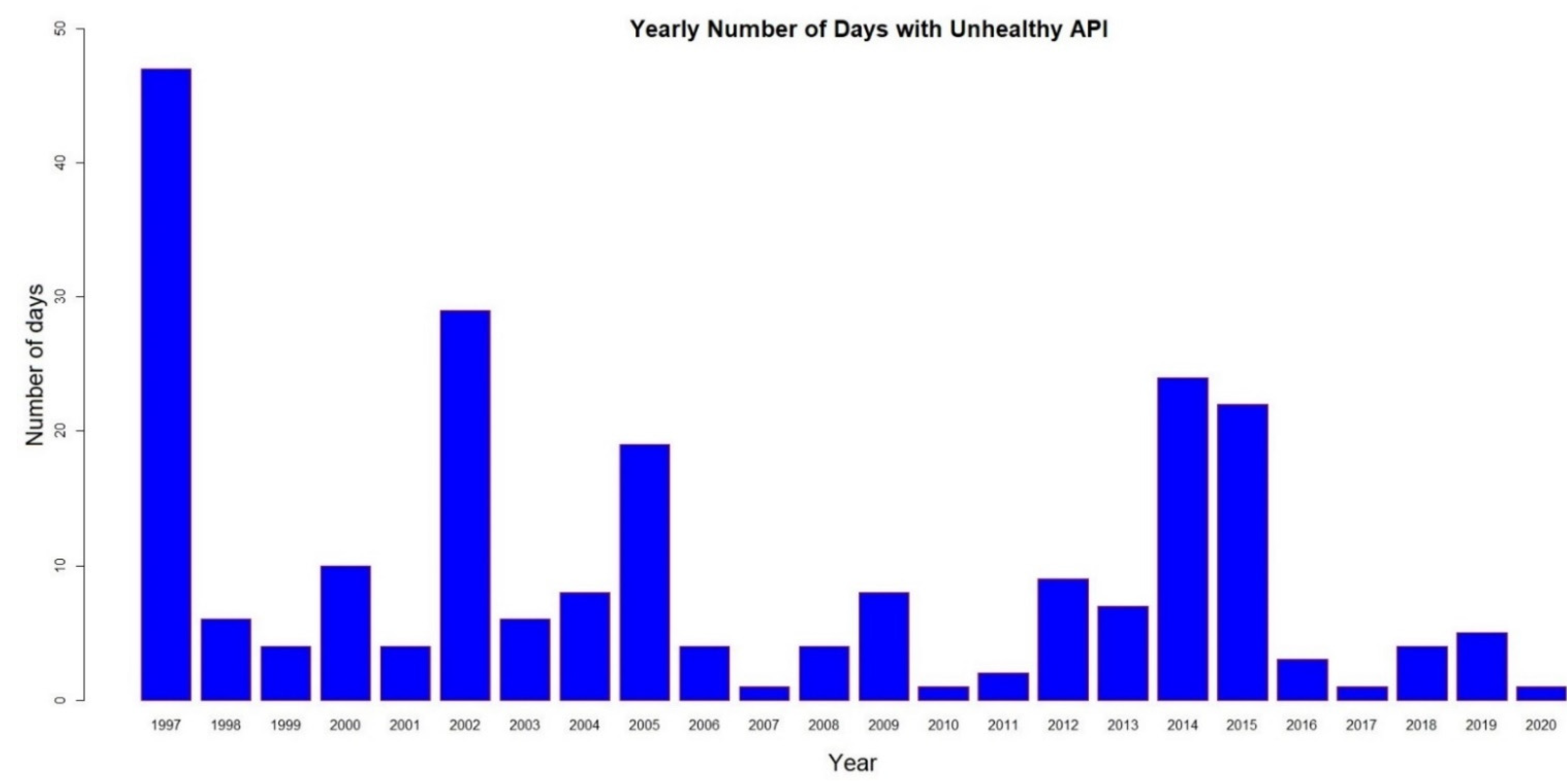
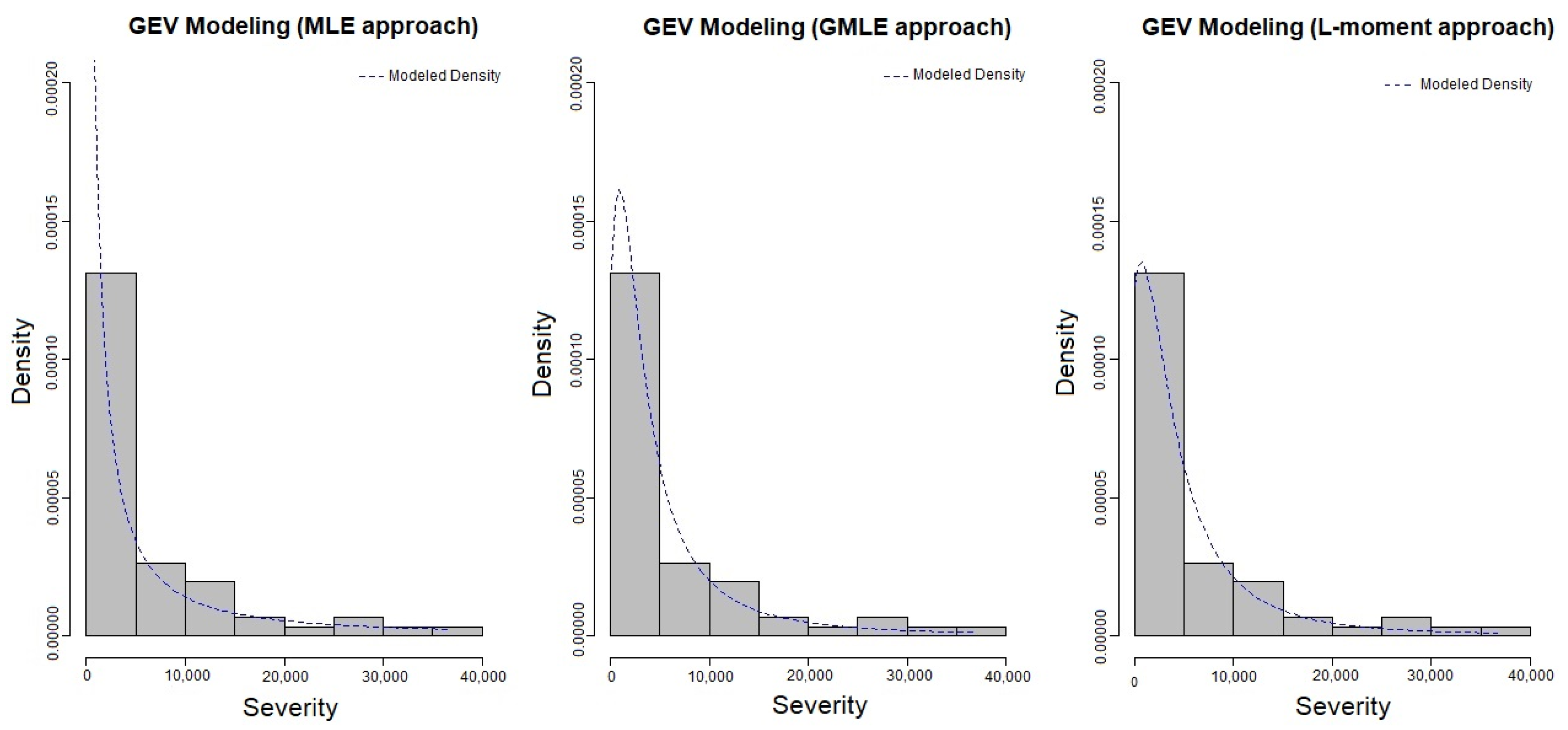

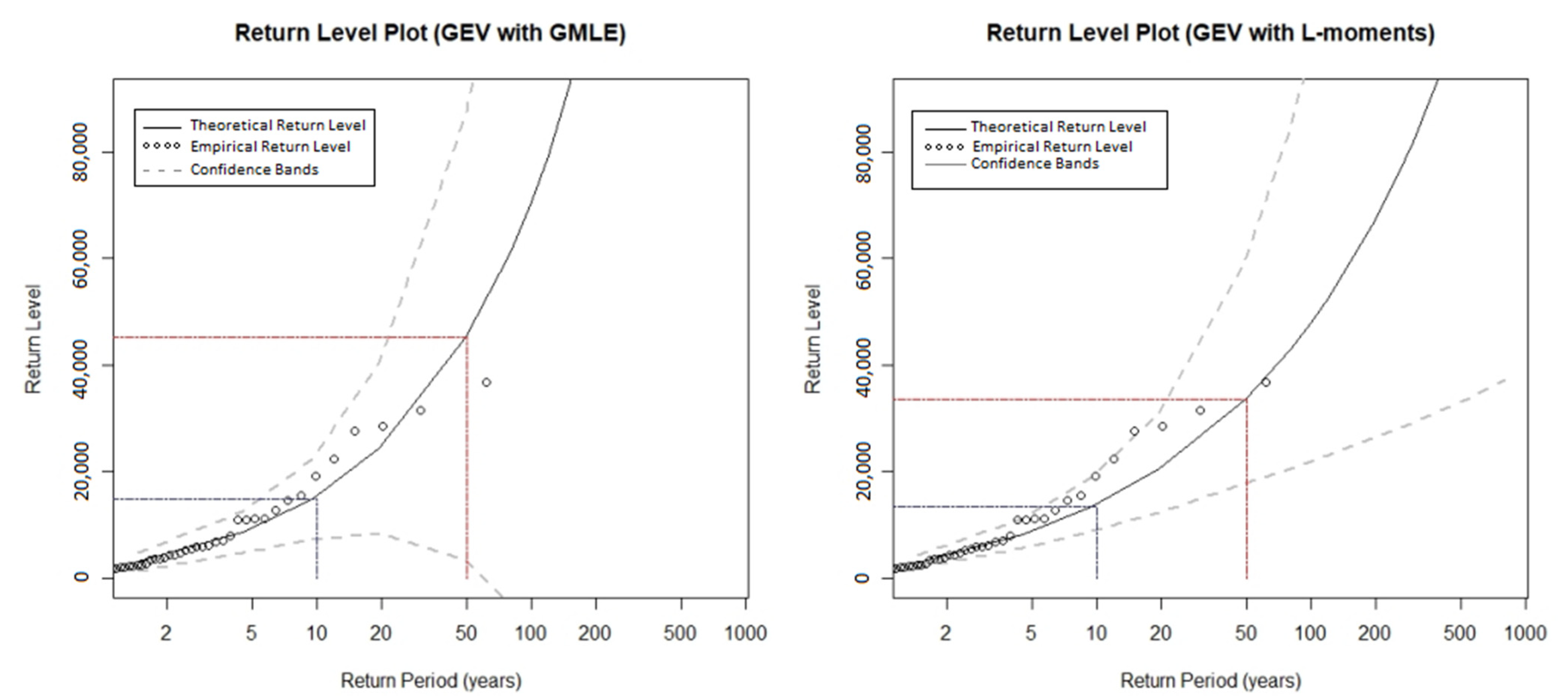
| API | Status | Health Effect | Health Advice |
|---|---|---|---|
| 0–50 | Good | Low pollution without a bad effect on health. | Outdoor activities are not restricted. Maintain healthy lifestyle. |
| 51–100 | Moderate | Moderate pollution that does not pose any bad effect on health. | Outdoor activities are not restricted. Maintain healthy lifestyle. |
| 101–200 | Unhealthy | Worsens the health condition of high-risk people, i.e., people with heart and lung complications. | Outdoor activities for high-risk people are limited. The public needs to reduce extreme outdoor activities. |
| 201–300 | Very Unhealthy | Worsens the health condition and lowers tolerance to physical exercises of people with heart and lung complications, affects public health. | Elderly and high-risk people are prohibited from outdoor activities. The public is advised to refrain from outdoor activities. |
| 301–500 | Hazardous | Hazardous to high-risk people and public health. | Elderly and high risk people are prohibited from outdoor activities. The public is advised to refrain from outdoor activities. |
| >500 | Emergency | Hazardous to high-risk people and public health. | The public is advised to follow orders from the National Security Council and always follow the announcements in mass media. |
| Data | Mean | Minimum | Maximum | Std. Deviation | Skewness | Kurtosis |
|---|---|---|---|---|---|---|
| Observed API | 55.221 | 0 | 543 | 20.970 | 4.537 | 65.133 |
| Model | Estimated Parameter | ||
|---|---|---|---|
| GEV based on L-moments | 1790.661 | 2975.936 | 0.452 |
| GEV based on MLE | 1584.359 | 2997.820 | 1.824 |
| GEV based on GMLE | 1996.137 | 2663.216 | 0.613 |
| Return Period | Return Level Estimation Air Pollution Severity |
|---|---|
| 2 years | 3090.557 |
| 3 years | 5206.969 |
| 5 years | 6975.709 |
| 6 years | 8546.659 |
| 7 years | 11,319.008 |
| 8 years | 12,576.375 |
| 9 years | 13,769.592 |
| 10 years | 14,909.100 |
Publisher’s Note: MDPI stays neutral with regard to jurisdictional claims in published maps and institutional affiliations. |
© 2022 by the authors. Licensee MDPI, Basel, Switzerland. This article is an open access article distributed under the terms and conditions of the Creative Commons Attribution (CC BY) license (https://creativecommons.org/licenses/by/4.0/).
Share and Cite
Masseran, N.; Safari, M.A.M. Statistical Modeling on the Severity of Unhealthy Air Pollution Events in Malaysia. Mathematics 2022, 10, 3004. https://doi.org/10.3390/math10163004
Masseran N, Safari MAM. Statistical Modeling on the Severity of Unhealthy Air Pollution Events in Malaysia. Mathematics. 2022; 10(16):3004. https://doi.org/10.3390/math10163004
Chicago/Turabian StyleMasseran, Nurulkamal, and Muhammad Aslam Mohd Safari. 2022. "Statistical Modeling on the Severity of Unhealthy Air Pollution Events in Malaysia" Mathematics 10, no. 16: 3004. https://doi.org/10.3390/math10163004
APA StyleMasseran, N., & Safari, M. A. M. (2022). Statistical Modeling on the Severity of Unhealthy Air Pollution Events in Malaysia. Mathematics, 10(16), 3004. https://doi.org/10.3390/math10163004





